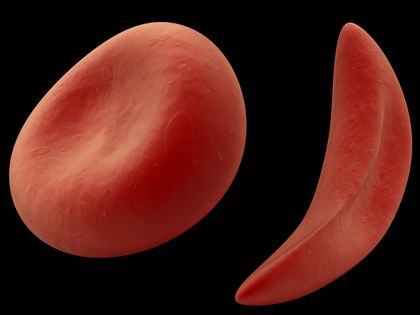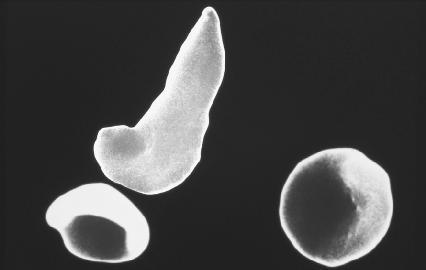Sickle Cell Anemia - Description

Blood is made up of many kinds of cells, including red blood cells (RBCs). An important function of RBCs is to carry oxygen from the lungs to cells throughout the body. Red blood cells contain a molecule known as hemoglobin (pronounced HEE-muh-GLOW-bihn) that collects oxygen from the lungs then releases it when the RBC reaches other cells in the body.
Normally, red blood cells have a plump doughnut shape. In some cases, however, a person's body makes red blood cells that are curved with sharp points at the end. They are called sickle cells because they look like a sickle (a long farm tool with a curved blade that is used to cut grain).
Hemoglobin Genes
Sickle cell anemia is caused by defective genes. Genes are chemical units found in all cells that tell cells what functions to perform. For example, RBCs contain genes that tell the cell how to make hemoglobin molecules.
When a gene becomes damaged, the message it carries to the cell is incorrect. A damaged gene for hemoglobin tells the cell to make the wrong kind of hemoglobin. This defective hemoglobin creates a sickle shaped RBC rather than the correct doughnut-shaped RBC.
- Anemia:
- A condition caused by a decrease in the number of red blood cells in the blood, characterized by fatigue, pale color of the skin, and shortness of breath.
- Antibiotic:
- A substance derived from bacteria or other organisms that fights the growth of other bacteria or organisms.
- Bone marrow:
- A spongy tissue in the center of bones where blood cells are produced.
- Bone marrow transplantation:
- A process by which marrow is removed from the bones of a healthy donor and transferred to the bones of a person's with some kind of blood disorder.
- Gel electrophoresis:
- A laboratory test that separates different types of molecules from each other.
- Hemoglobin:
- A molecule found in blood that gives blood its red color. Hemoglobin is responsible for transporting oxygen through the blood stream.
- Hydroxyurea:
- An experimental drug being tested for use with sickle cell anemia patients.
- Red blood cell (RBC):
- Blood cells that transport oxygen and carbon dioxide through the blood stream.
- Sickle cell:
- A red blood cell with an abnormal shape due to the presence of an abnormal form of hemoglobin.
Genes are passed from both parents to their children. A person who receives a damaged hemoglobin gene from just one parent will not get sickle cell anemia. People who have only one defective hemoglobin gene are called carriers. Being a carrier of this particular defective gene may actually increase a person's resistance to malaria (see malaria entry), a dangerous infectious disease. However, if a person receives a defective hemoglobin gene from both parents, he or she will develop sickle cell anemia.
Problems Associated with Sickle Cell Anemia
The presence of sickle cells in the blood can cause many health problems. For instance, sickle cells die more rapidly than normal cells. When this happens, the body often cannot produce new blood cells fast enough to replace the dying ones. Such a loss of RBCs can lead to anemia (pronounced uh-NEE-mee-uh; see anemia entry). Anemia is a disorder caused by an insufficient number of red blood cells.
Sickle cells can also cause health problems because of they tend to stick to each other and to the sides of blood vessels. As they clump or build up they can eventually block the flow of blood through a blood vessel. This blockage limits the flow of blood to cells, keeping them from getting the oxygen they need, and can eventually cause the cells to die.
Blockage can also lead to a stroke. If the clump of cells blocking a vessel breaks loose it may travel to the brain. If the clump blocks blood flow

to the brain it can cause damage to the brain known as a stroke (see stroke entry).
Sickle cell anemia occurs primarily among people with African, Mediterranean, Middle Eastern, and Indian ancestry. Worldwide, about 250,000 children are born each year with sickle cell anemia. About two million Americans are thought to have at least one damaged hemoglobin gene. Approximately 72,000 Americans have two damaged hemoglobin genes and therefore have sickle cell anemia.
In the United States, the condition is most common among African Americans. About 1 in 12 African Americans is a carrier for sickle cell anemia. Hispanic Americans are also heavily affected. About 1 in every 1,000 to 1,400 Hispanic American babies are born with sickle cell anemia.

Comment about this article, ask questions, or add new information about this topic: